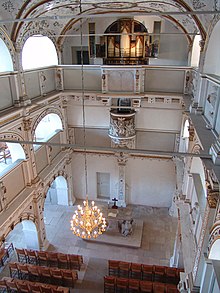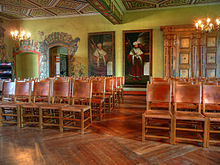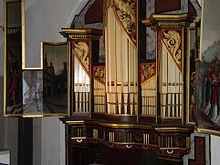
Kassel is a city on the Fulda River in northern Hesse, in central Germany. It is the administrative seat of the Regierungsbezirk Kassel and the district of the same name, and had 201,048 inhabitants in December 2020. The former capital of the state of Hesse-Kassel, it has many palaces and parks, including the Bergpark Wilhelmshöhe, which is a UNESCO World Heritage Site. Kassel is also known for the documenta exhibitions of contemporary art. Kassel has a public university with 25,000 students (2018) and a multicultural population.
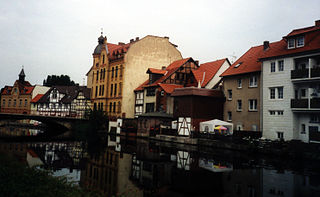
Eschwege, the district seat of the Werra-Meißner-Kreis, is a town in northeastern Hesse, Germany. In 1971, the town hosted the eleventh Hessentag state festival.

Meiningen is a town in the southern part of the state of Thuringia, Germany. It is located in the region of Franconia and has a population of around 26,000 (2024). Meiningen is the capital and the largest town of the Schmalkalden-Meiningen district. From 1680 to 1920, Meiningen was the capital of the Duchy of Saxe-Meiningen.

Frederiksborg Castle is a palatial complex in Hillerød, Denmark. It was built as a royal residence for King Christian IV of Denmark-Norway in the early 17th century, replacing an older castle acquired by Frederick II and becoming the largest Renaissance residence in Scandinavia. On three islets in the Slotssøen, it is adjoined by a large formal garden in the Baroque style.

Schmalkalden is a town in the Schmalkalden-Meiningen district, in the southwest of the state of Thuringia, Germany. It is on the southern slope of the Thuringian Forest at the Schmalkalde river, a tributary to the Werra. As of 31 December 2022, the town had a population of 20,065.
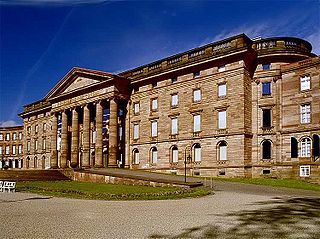
The Wilhelmshöhe Palace is a Neoclassical palace located in Bad Wilhelmshöhe, a part of Kassel, Germany. It was built for Landgrave Wilhelm (William) IX of Hesse in the late 18th century. Emperor Wilhelm II made extensive use of it as a summer residence and personal retreat.
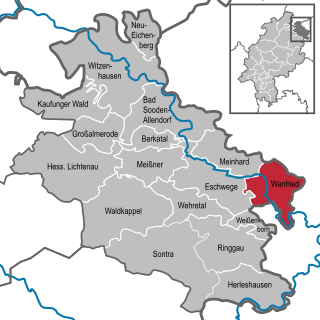
Wanfried is a town in the Werra-Meißner-Kreis in northeasternmost Hesse, Germany. It is classified as a Landstadt, a designation given in Germany to a municipality that is officially a town (Stadt), but whose population is below 5,000. It literally means “country town”.

Christoph of Württemberg, ruled as Duke of Württemberg from 1550 until his death in 1568.

Barchfeld is a village and a former municipality in the Wartburgkreis district of Thuringia, Germany. Since 31 December 2012, it is part of the municipality Barchfeld-Immelborn.

Glücksburg Castle is one of the most significant Renaissance castles in Northern Europe.

Bergpark Wilhelmshöhe is a landscape park in Kassel, Germany. The area of the park is 2.4 square kilometres, making it the largest European hillside park, and second largest park on a hill slope in the world. Construction of the Bergpark, or "mountain park", began in 1689 at the behest of the Landgraves of Hesse-Kassel and took about 150 years. The park is open to the public today. Since 2013, it has been a UNESCO World Heritage Site because of its monumental Baroque architecture and its unique fountains and water features.
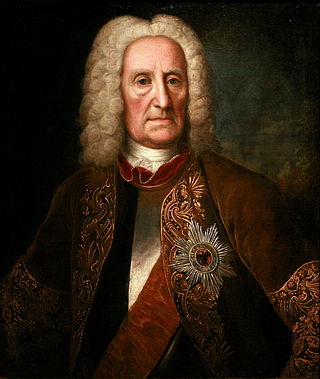
Johann Reinhard III of Hanau-Lichtenberg was the last of the counts of Hanau-Lichtenberg. He reigned from 1680 to 1736. From 1712 to 1736, he also reigned the County of Hanau-Münzenberg.

Elisabeth of Hesse was Hereditary Princess of Saxony in 1519-1537 by marriage to John of Saxony. After the death of her husband, she managed her Wittum, the Saxon districts of Rochlitz and Kriebstein between 1537 and 1547, earning her the name Elisabeth of Rochlitz. She allowed for the spread of Protestantism in her territories. She acted as mediator between her Catholic mother and Lutheran brother, and as the nurse of Maurice of Saxony.

Hedwig of Hesse-Kassel was a princess of Hesse-Kassel by birth and by marriage a Countess of Schaumburg.

A staircase tower or stair tower is a tower-like wing of a building with a circular or polygonal plan that contains a stairwell, usually a helical staircase.

Bellevue Palace in Kassel was built in 1714 for Charles I, Landgrave of Hesse-Kassel. Originally the building served as an Observatory. It became a residence, and then part of Bellevue Castle, which was later destroyed. Until its closure for structural reasons in 2009, the building housed a museum devoted to the Grimm Brothers, which has now moved to the Grimmwelt Kassel.
A pulpit altar or pulpit-altar is an altar in a church that is built together with a pulpit that is designed as an extension above the altar, so the pulpit, altar, and altarpiece form one unit. This type of altar is typical in a Baroque style church whereas earlier medieval churches and many more modern churches tend to have the more common free-standing pulpit that was set apart from the altar. This design became popular after the Protestant Reformation in Lutheran churches. It was first built to emphasize the importance of the sermon and the preaching of the Word of God in the worship service. It also symbolizes that the Word of God stands together with the sacraments which takes place on the altar below. The first pulpit altars appeared in the German areas of Europe and in the baroque churches of the 1600s and 1700s. Sometimes the organ was placed above the pulpit as well to symbolize that music was also central to the church.

Landgrafenschloss Kassel or Stadtschloss Kassel is a former palace in Kassel, Germany, which served as a residence of the Landgraves and later Electors of Hesse-Kassel. Also, the brother of Napoleon, Jérôme Bonaparte lived here shortly as the King of Westphalia. In 1811, the city palace was destroyed by a fire and not restored afterwards.

The Blumenstein summer palace, also named Schloss Wildeck, is a former neoclassical palace in Wildeck, in northeastern Hesse, Germany. It was a hunting lodge and summer residence of landgraves of Hessen-Rotenburg. Once it was called the Hessian Sanssouci, so fantastic were the palace and the English landscape garden parks that were located here. When the last landgrave passed away in 1834, the palace fell into oblivion. Today, there are remains of the palace gardens and some of its ancillary buildings.



